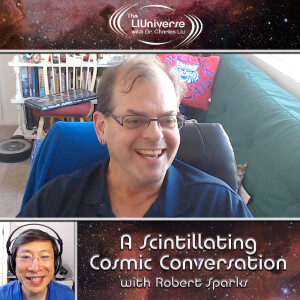
Saturday Jan 25, 2025
A Scintillating Cosmic Conversation with Robert Sparks
Have you ever wondered how data from the telescopes that peer into our universe ends up in the hands of the astronomers who interpret it? To find out, Dr. Charles Liu and co-host Allen Liu welcome Robert Sparks, currently from the NSF’s NOIRLab, but previously Fermi Lab and the Sloan Sky Survey.
The National Optical InfraRed Astronomy Research Lab is responsible for operating the National Science Foundation’s ground based, nighttime optical and near infrared astronomy for the United States. Robert describes their Community Science Data Center which ties all the data from all their telescopes together to make it available for astronomers around the world to use in their research.
As always, though, we start off with the day’s joyfully cool cosmic thing, a project coming out of NOIRLab called 88 Constellations. Robert, who spearheaded the project, explains how the final, incredibly detailed image combined classic constellations and new, modern additions and covered the entire sky. One of his favorite parts of the project? Learning about the constellations in the southern hemisphere that doesn’t get to see that often, like the Southern Cross. Chuck, Allen and Robert share some of their experiences stargazing down below, and yes, you know Chuck takes the opportunity to sing us a little Crosby, Stills and Nash! You’ll also hear which constellation is the smallest in the southern hemisphere, Crux (the Southern Cross) or Delphinus.
Then it’s on to audience questions. Our first comes from Amirah, who asks, “Blue stars are hotter than red stars, so does that mean blue light bulbs are hotter than red light bulbs? Why would something's color matter about how hot something is?” The short answer: yes (pre-LED, that is!) Robert’s long answer involves black body radiation, the electromagnetic spectrum, and red giant carbon stars.
Rob shares stories from a career that bridges astronomy and particle physics, including how he got his hands on some original scintillator material from particle detectors at Fermi Lab. (Check out The LIUniverse on Patreon for a scintillating deep dive into…well, scintillation!)
The next audience question, from Bryan, is particularly relevant to the discussion: How do astronomy and physics work together? In many, ways, as Robert and Chuck explain. Allen shares the story of the discovery of the element Helium, which was first discovered in the Sun by astronomers, hence its name.
You’ll also get to hear about Robert’s 38-year-long career in improv comedy – and get to watch him (and his cat) act out scenes prompted by Chuck.
Finally, we’ve got one last audience question from Jerry, who says, “I live really far away from the city and I don't have a telescope. What's the best way for me to do astronomy research?” Robert, who grew up in Iowa, tells Jerry about citizen science astronomy projects he can get involved like those at The Zooniverse. You’ll hear about how, while working at a program there known as the Galaxy Zoo, a Dutch schoolteacher named Hanny Van Arkel discovered a weird light echo from a quasar that is now known as “Hanny’s Voorwep” (Hanny’s Object).
If you’d like to find out more about NOIRLab, the National Optical InfraRed Astronomy Research Lab, check out their website.
To keep up with Robert Sparks, you can follow him @halfastro on Bluesky, Threads, Flikr, and Instagram.
We hope you enjoy this episode of The LIUniverse, and, if you do, please support us on Patreon.
Credits for Images Used in this Episode:
- Mauna Kea observatories in Hawaii – Credit: Wikicommons/Alan L.
- Kitt Peak National Observatory (KPNO) in Arizona. – Credit: KPNO/NOIRLab/NSF/AURA/T. Slovinský
- 3-D view of the largest structures in the Universe via data from the Sloan Digital Sky Survey. – Credit: NASA/University of Chicago and Adler Planetarium and Astronomy Museum
- 88 Constellation sky-scape video compiled using images from the best and darkest locations around the globe: Germany (Waldenburg), Spain (Tenerife, La Palma), Namibia and Chile. – Credit: NOIRLab/NSF/AURA/E. Slawik/M. Zamani
- The constellation Crux (Southern Cross) – Credit: E. Slawik/NOIRLab/NSF/AURA/M. Zamani
- The constellation Delphinus – Credit: E. Slawik/NOIRLab/NSF/AURA/M. Zamani
- Illustration of the spectrum of electromagnetic energy, highlighting the portions detected by NASA’s Hubble, Spitzer, and Webb space telescopes – Credit NASA
- Event captured by the Super Kamiokande detector – Credit: Tomasz Barszczak/Super-Kamiokande collaboration
- Visualization of two colliding galaxies that merge into a single elliptical galaxy over a period spanning two billion years – Credits: NCSA, NASA, B. Robertson, L. Hernquist
- Helium spectral lines which appear in the visible spectrum at about 400-700 nanometers. – Credit: Creative Commons/ McZusatz
- Hanny’s Voorwep, A Space Oddity – Credit: NASA, ESA, W. Keel (University of Alabama), and the Galaxy Zoo Team
#TheLIUniverse #CharlesLiu #AllenLiu #SciencePodcast #AstronomyPodcast #NOIRLab #NSF #FermiLab #SloanDigitalSkySurvey #88Constellations #GalaxyZoo #TheZooniverse #blackbodyradiation #electromagneticspectrum #redgiants #carbonstars #particlephysics #scintillatormaterial #particledetectors #scintillation #HannysVoorwep
No comments yet. Be the first to say something!